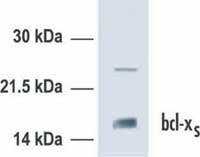PC89 Sigma-AldrichAnti-Bcl-xs (Ab-1) (119-131) Rabbit pAb
Recommended Products
Přehled
| Replacement Information |
|---|
Tabulka spec. kláve
| Host |
|---|
| Rb |
| Product Information | |
|---|---|
| Form | Liquid |
| Formulation | In 0.05 M sodium phosphate buffer, 0.2% gelatin. |
| Positive control | Doxorubicin-induced MCF7 or HeLa cells or thymocytes |
| Preservative | ≤0.1% sodium azide |
| Physicochemical Information |
|---|
| Dimensions |
|---|
| Materials Information |
|---|
| Toxicological Information |
|---|
| Safety Information according to GHS |
|---|
| Safety Information |
|---|
| Product Usage Statements |
|---|
| Storage and Shipping Information | |
|---|---|
| Ship Code | Blue Ice Only |
| Toxicity | Standard Handling |
| Storage | +2°C to +8°C |
| Do not freeze | Yes |
| Packaging Information |
|---|
| Transport Information |
|---|
| Supplemental Information |
|---|
| Specifications |
|---|
| Global Trade Item Number | |
|---|---|
| Katalogové číslo | GTIN |
| PC89 | 0 |
Documentation
Anti-Bcl-xs (Ab-1) (119-131) Rabbit pAb MSDS
| Title |
|---|
Anti-Bcl-xs (Ab-1) (119-131) Rabbit pAb Certificates of Analysis
| Title | Lot Number |
|---|---|
| PC89 |
References
| Přehled odkazů |
|---|
| Bargou, R.C., et al. 1995. Eur. J. Immunol. 25, 770. Dole, M.G., et al. 1995. Cancer Res. 55, 2576. Zhang,H., et al. 1995. Biochem. Biophys. Res. Commun. 208, 950. Fang, W., et al. 1994. J. Immunol. 153, 4388. Krajewski, S., et al. 1994. Cancer Res. 54, 5501. Nunex, G. et al. 1994. Immunol. Today 15, 582. Boise L.H., et al. 1993. Cell 74, 597. Cazais-Hatem, D.L., et al. 1992. Biochim. Biophys. Acta 1132, 109. |
Brochure
| Title |
|---|
| Caspases and other Apoptosis Related Tools Brochure |

















